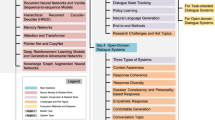Abstract
This work presents a novel methodology to train open domain neural dialogue systems within the framework of Generative Adversarial Networks with gradient based optimization methods. We avoid the non-differentiability related to text-generating networks approximating the word vector corresponding to each generated token via a top-k softmax. We show that a weighted average of the word vectors of the most probable tokens computed from the probabilities resulting of the top-k softmax leads to a good approximation of the word vector of the generated token. Finally we demonstrate through a human evaluation process that training a neural dialogue system via adversarial learning with this method successfully discourages it from producing generic responses. Instead it tends to produce more informative and variate ones.
Access this chapter
Tax calculation will be finalised at checkout
Purchases are for personal use only
Similar content being viewed by others
References
Bahdanau D, Cho K, Bengio Y (2014) Neural machine translation by jointly learning to align and translate. arXiv preprint arXiv:14090473
Bengio S, Vinyals O, Jaitly N, Shazeer N (2015) Scheduled sampling for sequence prediction with recurrent neural networks. In: Advances in neural information processing systems, pp 1171–1179
Bengio Y, Léonard N, Courville A (2013) Estimating or propagating gradients through stochastic neurons for conditional computation. arXiv preprint arXiv:13083432
Bojanowski P, Grave E, Joulin A, Mikolov T (2016) Enriching word vectors with subword information. arXiv preprint arXiv:160704606
Bowman SR, Vilnis L, Vinyals O, Dai AM, Jozefowicz R, Bengio S (2015) Generating sentences from a continuous space. arXiv preprint arXiv:151106349
Ghazvininejad M, Brockett C, Chang MW, Dolan B, Gao J, Yih W, Galley M (2017) A knowledge-grounded neural conversation model. arXiv preprint arXiv:170201932
Goodfellow I, Pouget-Abadie J, Mirza M, Xu B, Warde-Farley D, Ozair S, Courville A, Bengio Y (2014) Generative adversarial nets. In: Advances in neural information processing systems, pp 2672–2680
Honnibal M, Montani I (2017) Spacy 2: natural language understanding with bloom embeddings, convolutional neural networks and incremental parsing. To appear
Hori T, Wang W, Koji Y, Hori C, Harsham B, Hershey JR (2019) Adversarial training and decoding strategies for end-to-end neural conversation models. Comput Speech Lang 54:122–139
Jang E, Gu S, Poole B (2016) Categorical reparameterization with gumbel-softmax. arXiv preprint arXiv:161101144
Kannan A, Vinyals O (2017) Adversarial evaluation of dialogue models. arXiv preprint arXiv:170108198
Kingma DP, Ba J (2014) Adam: a method for stochastic optimization. arXiv preprint arXiv:14126980
Kusner MJ, Hernández-Lobato JM (2016) Gans for sequences of discrete elements with the gumbel-softmax distribution. arXiv preprint arXiv:161104051
Li J, Monroe W, Shi T, Jean S, Ritter A, Jurafsky D (2017) Adversarial learning for neural dialogue generation. arXiv preprint arXiv:170106547
Lison P, Tiedemann J (2016) Opensubtitles2016: extracting large parallel corpora from movie and tv subtitles. European language resources association
Lu J, Kannan A, Yang J, Parikh D, Batra D (2017) Best of both worlds: transferring knowledge from discriminative learning to a generative visual dialog model. In: Advances in neural information processing systems, pp 314–324
Luong MT, Pham H, Manning CD (2015) Effective approaches to attention-based neural machine translation. arXiv preprint arXiv:150804025
Maddison CJ, Mnih A, Teh YW (2016) The concrete distribution: a continuous relaxation of discrete random variables. arXiv preprint arXiv:161100712
Serban IV, Sordoni A, Bengio Y, Courville AC, Pineau J (2016) Building end-to-end dialogue systems using generative hierarchical neural network models. AAAI 16:3776–3784
Shetty R, Rohrbach M, Hendricks LA, Fritz M, Schiele B (2017) Speaking the same language: matching machine to human captions by adversarial training. In: Proceedings of the IEEE international conference on computer vision (ICCV)
Sordoni A, Galley M, Auli M, Brockett C, Ji Y, Mitchell M, Nie JY, Gao J, Dolan B (2015) A neural network approach to context-sensitive generation of conversation responses. arXiv preprint arXiv:150606714
Sutskever I, Vinyals O, Le QV (2014) Sequence to sequence learning with neural networks. In: Advances in neural information processing systems, pp 3104–3112
Tuan YL, Lee HY (2019) Improving conditional sequence generative adversarial networks by stepwise evaluation. IEEE/ACM Trans Audio, Speech, Lang Process
Vinyals O, Le Q (2015) A neural conversational model. arXiv preprint arXiv:150605869
Wu L, Xia Y, Zhao L, Tian F, Qin T, Lai J, Liu TY (2017) Adversarial neural machine translation. arXiv preprint arXiv:170406933
Xu J, Ren X, Lin J, Sun X (2018) Diversity-promoting gan: A cross-entropy based generative adversarial network for diversified text generation. In: Proceedings of the 2018 conference on empirical methods in natural language processing, pp 3940–3949
Yu L, Zhang W, Wang J, Yu Y (2017) Seqgan: sequence generative adversarial nets with policy gradient. In: AAAI, pp 2852–2858
Acknowledgements
This work has been partially funded by the Basque Government under grant PRE_2017_1_0357, by the University of the Basque Country UPV/EHU under grant PIF17/310, and by the H2020 RIA EMPATHIC (Grant N: 769872).
Author information
Authors and Affiliations
Corresponding author
Editor information
Editors and Affiliations
Rights and permissions
Copyright information
© 2021 The Author(s), under exclusive license to Springer Nature Singapore Pte Ltd.
About this chapter
Cite this chapter
López Zorrilla, A., deVelasco Vázquez, M., Torres, M.I. (2021). A Differentiable Generative Adversarial Network for Open Domain Dialogue. In: Marchi, E., Siniscalchi, S.M., Cumani, S., Salerno, V.M., Li, H. (eds) Increasing Naturalness and Flexibility in Spoken Dialogue Interaction. Lecture Notes in Electrical Engineering, vol 714. Springer, Singapore. https://doi.org/10.1007/978-981-15-9323-9_24
Download citation
DOI: https://doi.org/10.1007/978-981-15-9323-9_24
Published:
Publisher Name: Springer, Singapore
Print ISBN: 978-981-15-9322-2
Online ISBN: 978-981-15-9323-9
eBook Packages: EngineeringEngineering (R0)




